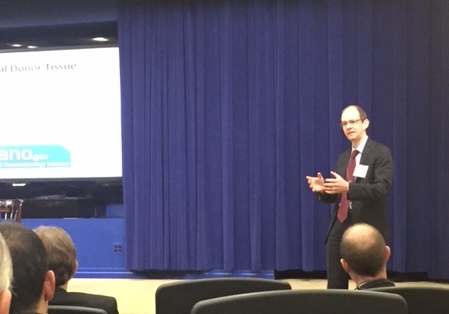The White House Addresses Organ Shortage in Regenerative Medicine Conference

The lack of donor organs remains the principal limitation to the field of transplantation. In 2014, wait-listed patients exceeded donors by almost tenfold. As the field of regenerative medicine advances, bioengineered tissues and organs could one day help close this gap. It’s a positive sign that the White House has expressed interest in supporting research in this area. I have invited my colleague, Jason Wertheim, to share details from a recent conference hosted by the White House Office of Science and Technology Policy (OSTP) addressing this subject.
The White House Addresses Organ Shortage in Regenerative Medicine Conference
Jason Wertheim, MD, PhD, Northwestern University – Chair of the AST’s Transplant Regenerative Medicine COP
The White House OSTP hosted a half-day conference on Thursday, May 28th that focused on regenerative medicine strategies to address donor organ shortage. Scientists, physicians, and transplant groups came together with key players in governmental agencies to discuss methods of advancing regenerative medicine research and advocating for government assistance to promote the field.
The American Society of Transplantation (AST) was well-represented at this meeting: Dr. Alejandro Soto-Gutierrez and I attended from the AST’s Transplantation Regenerative Medicine Community of Practice (COP), along with Dr. Gerald Brandacher, the past-chair of the AST’s Vascular Composite Allotransplant Advisory Council, and Emily Wilson, one of the AST's bipartisan lobbyists who represents the society in Washington, DC with Bryan Cave LLP. Other attendees included transplant-related organizations such as the American Society of Nephrology and the Global Liver Institute, the Alliance for Regenerative Medicine, and various government agencies (NIH, NIST, NSF, DOD, Army, BARDA, and NASA). New Organ and the Organ Preservation Alliance organized both the conference and a one-day roadmap development session the day before.
The group focused on novel cell, tissue, and organ preservation strategies and the development of new cell populations that may require less (or no) immunosuppression once transplanted. One particular focus area for the current administration is the promotion of new manufacturing processes, particularly for biomedical applications. An early manufacturing initiative of the Obama Administration, announced in 2012 and called the “National Additive Manufacturing Innovation Institute (NAMII),” is located in Youngstown, Ohio. This center specializes in developing 3D printing, which will revolutionize the way industrial parts – or possibly even organs – are designed and produced.
During the one-day development session before the OSTP meeting, discussion centered on 3D bioprinting, tissue bioengineering, and tissue preservation technology. Among this crosscutting group of both clinicians, scientists, and representatives from government agencies, we were able to discuss the science behind these technologies and brainstorm strategies to solve problems. Increased federal funding for this research was a common theme. A new strategy that was discussed to advance technological development in this area is the development of incentive prizes, which some agencies, including NASA, have recently instituted. At the conference, NASA announced a Centennial Challenge in Tissue Engineering. This 2015 Centennial Challenge will reward the first team or individual to successfully develop vascularized, functional tissue in vitro, which would be an amazing development for our field.
All together, the symposium brought several key players to brainstorm new strategies for addressing the organ shortage. The immediate success of this meeting is that we continued the discussion about new technologies that can preserve and develop tissues, and we brought government agencies together to develop a coordinated approach to the multidisciplinary challenge of developing new cells and tissues for transplantation.
I highly encourage anyone who would like to become more involved in the activities and research discussed herein to join the AST’s new Transplantation Regenerative Medicine COP. It’s an exciting time to be working in this space.


Comments
Organ Shortage-USA
RE: Organ Shortage-USA: Exploitation or Opportunity?
I was watching the TV show “Deadliest Catch” the other night and was wondering why in the world anyone would want to risk his or her life standing on a pitching boat, wet and cold, in the middle of the Bering Sea. I suspect that for many of these hardy fishermen, the principal reason is that they can make $40,000 in several weeks. Perhaps I am underestimating their love for the sea, or some inner joy that comes with pulling up a full pot of crabs, but I don’t think so. My grandfather grew up in Scotland, and worked fishing boats north of the Arctic Circle for much of his childhood. He said that it was miserable and that he was never warm or dry a day in his life before he immigrated to America. He fished only to make the money needed to by a one-way ticket to New York.
Dr. Pollak gives us a number of examples close to our field where economic incentivization drives human behavior. Another such example is the tale of blood vs. plasma. We have a perpetual domestic shortage of blood, yet we are the biggest exporters of plasma in the world. Why? I would postulate that it is simply because blood donors are mandated to be volunteers, and plasma donors are paid. In truth, we all have a price at which we will do something that we otherwise wouldn't (with the provision for most people that the "something" does not violate our moral code.) In fact, we use money all the time to compensate people to do things that they ordinarily wouldn’t want to do—and it works. Soldiers in combat get 'combat pay'. A truck driver hauling hazardous cargo earns more money than one hauling fruit on the exact same route.
Nonetheless, while most transplant professionals and patients agree that no one should be economically disadvantaged to fulfill a wish to be an organ donor, many still have concerns that putting a price on the human body cheapens our humanity and would just be one more example where those more desperate for money are taken advantage of by those more fortunate. Are we being overly paternalistic with this viewpoint? Perhaps the opportunity to freely consent to accepting payment in exchange for an organ is just the opportunity that someone needs to get out of poverty. This is why many people surrogate pregnancies for six-figure payments. Like my grandfather, this might be someone's ticket to a better life.
I'll be blogging more on these issues in the future as we lead up to this year's CEOT meeting. My hope is to stimulate respectful discussion on these topics—not to ram any one particular opinion down everyone's collective throats. Ultimately, the AST will be looked upon to lead responsibly for the benefit of our patients and society. It is through this debate that we are most likely to get it right.
The real promises of Regenerative Medicine
RE: The real promises of Regenerative Medicine
Regenerative medicine versus xenotransplantation
I cannot understand why so much emphasis is being given to regenerative medicine when progress in xenotransplantation research is so much more advanced. Pig pancreatic islet, corneal, and heterotopic heart transplants have functioned for >1 year, and currently a pig kidney has been supporting the life of a nonhuman primate (NHP) for >8 months. This has all been achieved with modest immunosuppressive therapy. There is the potential to reduce this therapy by further genetic manipulation of the 'donor' pigs. Please show me life-supporting examples in the relevant NHP model from regenerative medicine research. I do not understand why xenotransplantation is not being given more support.
RE: Regenerative medicine versus xenotransplantation
I had the pleasure of working with Dr. Cooper at Mass. General a few years ago, and I share his sentiment that xenotransplantation holds significant promise to become a clinical reality in the near future. It's my view that this transformative event will come about through a combination of 1) genetically modifying the porcine donor, and 2)inducing tolerance in the human recipient. On the first front, new gene editing technologies, such as CRISPR/Cas9, are allowing genetic modifications to be made in record time, in order to "humanize" the pig. However, in the end a pig will still be a pig, and that is where tolerance induction comes into play. My work in the laboratory has centered around tolerance induction for NHP allo-lung transplantation, and I have successfully induced long-term tolerance in three fully mismatched monkeys (multi-year rejection free survival off all immunosuppression). I have focused on allo-tolerance mainly because I felt it was premature to strive for xenotolerance, before allo-tolerance can be reliably achieved. Nonetheless, I am confident that this approach will indeed be the next paradigm shift in transplantation. If successful, this would result in an unlimited supply of organs for everyone, with natural graft senescence being the only limitation on graft survival. For now, however, Dr. Cooper and I will need to endure the laughter and ridicule of our colleages, who think that we are nuts. It will only make the "I told you so!" more enjoyable.
In defense of my regenerative friends, I will say that I am excited by the prospect of repopulating a human organ scaffold with stem cells. I think that this approach is more likely to come to fruition sooner than the "Brave New World" concept of growing an entire organ de novo in a bioreactor from a pluripotent cell.
Jim
Add new comment